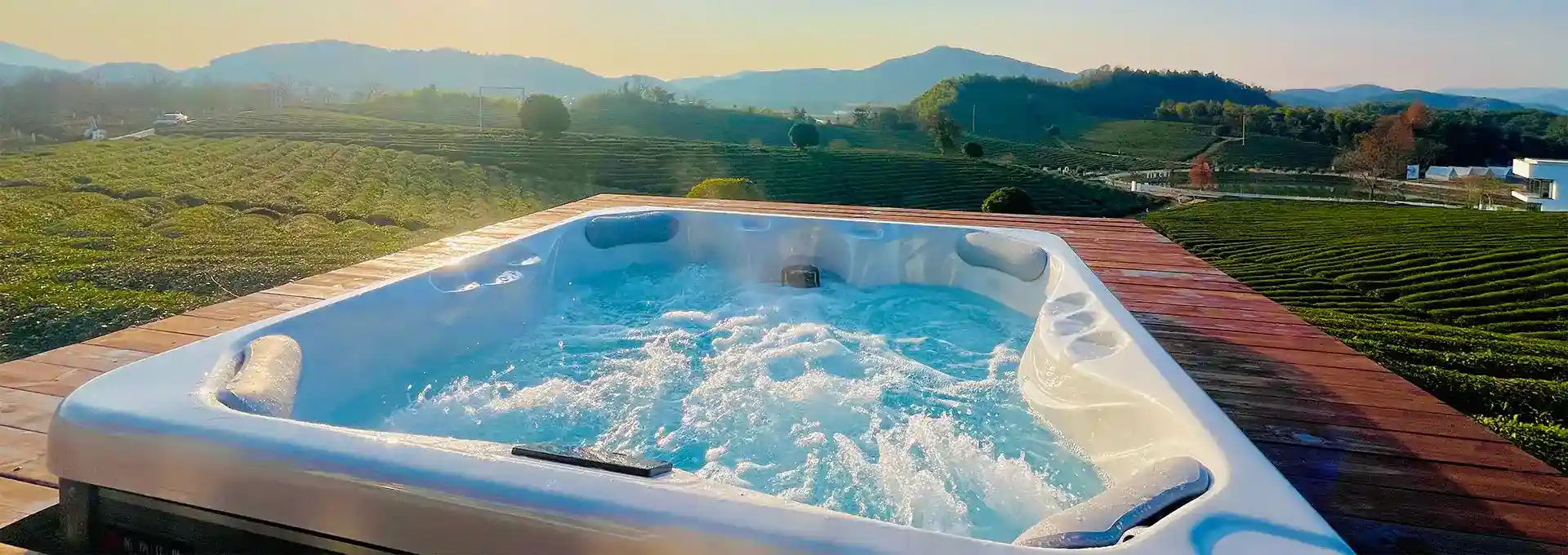What Type of Maintenance Does a Swim Spa Need?
2024-09-20 11:26:03
Swim spas have become increasingly popular for their versatility, offering the benefits of both a swimming pool and a hot tub in a compact, convenient package. However, like any water-based recreational equipment, swim spas require regular maintenance to ensure they remain clean, safe, and enjoyable for users. This blog post will delve into the essential maintenance tasks needed to keep your swim spa in top condition, with a focus on 7-person swim spas, which are a common size for both residential and commercial use.
How often should you clean a 7 person swim spa?
Maintaining a clean swim spa is crucial for both the health of its users and the longevity of the equipment. The frequency of cleaning a 7-person swim spa depends on several factors, including usage, environment, and water quality. However, there are general guidelines that swim spa owners should follow to ensure their unit remains in optimal condition.
Daily maintenance is the foundation of swim spa care. Each day, you should:
1. Check the water level and top it off if necessary.
2. Test the water chemistry using test strips or a digital tester.
3. Adjust chemicals as needed to maintain proper pH, alkalinity, and sanitizer levels.
4. Remove any visible debris with a skimmer net.
Weekly maintenance tasks are more thorough and include:
1. Cleaning the waterline with a soft cloth or sponge to remove any buildup.
2. Vacuuming the swim spa floor to remove settled debris.
3. Cleaning or replacing filters according to the manufacturer's instructions.
4. Shocking the water to eliminate contaminants and restore water clarity.
Monthly maintenance involves deeper cleaning and inspection:
1. Draining and refilling the swim spa (this may be needed more or less frequently depending on usage).
2. Cleaning the cabinet and cover to prevent mold and mildew growth.
3. Inspecting equipment for signs of wear or damage.
For a 7-person swim spa, which typically sees more use than smaller models, it's crucial to stay on top of these cleaning schedules. More frequent cleaning may be necessary during periods of heavy use or if the swim spa is located outdoors where it's exposed to more contaminants.
Remember that while regular cleaning is essential, it's equally important not to over-clean or use harsh chemicals that could damage the swim spa's surfaces or components. Always follow the manufacturer's guidelines and use products specifically designed for swim spas.
What chemicals are needed for a 7 person swim spa?
Proper chemical maintenance is vital for keeping the water in your 7-person swim spa clean, clear, and safe for use. The size of a 7-person swim spa means it requires careful attention to chemical balance, as more users can introduce more contaminants into the water. Here's a comprehensive list of chemicals needed and how to use them effectively:
1. Sanitizers:
- Chlorine or Bromine: These are the primary sanitizers used in swim spas. They kill bacteria and other harmful microorganisms. For a 7-person swim spa, you may need to add sanitizer more frequently due to higher usage.
- Mineral Purifiers: These can be used in conjunction with traditional sanitizers to reduce the amount of chlorine or bromine needed.
2. pH Adjusters:
- pH Increaser: Raises the pH level if it's too low.
- pH Decreaser: Lowers the pH level if it's too high.
- Maintaining the correct pH (ideally between 7.2 and 7.8) is crucial for swimmer comfort and the effectiveness of other chemicals.
3. Alkalinity Adjusters:
- Alkalinity Increaser: Raises the total alkalinity.
- Alkalinity Decreaser: Lowers the total alkalinity.
- Proper alkalinity (typically 80-120 ppm) helps stabilize pH levels.
4. Calcium Hardness Increaser:
- This helps prevent corrosion and foaming. The ideal range is typically 150-250 ppm for swim spas.
5. Shock Treatment:
- Non-Chlorine Shock: Oxidizes contaminants without raising chlorine levels.
- Chlorine Shock: Provides a high dose of chlorine to kill bacteria and break down organic compounds.
- For a 7-person swim spa, weekly shocking is often recommended, but may be needed more frequently with heavy use.
6. Enzymes and Clarifiers:
- These products help break down oils and organic matter, improving water clarity.
7. Stain and Scale Prevention:
- These chemicals help prevent mineral buildup on surfaces and equipment.
8. Foam Remover:
- Useful for eliminating foam caused by body oils, lotions, and other contaminants.
When using these chemicals in your 7-person swim spa, it's important to:
- Test the water regularly (at least 2-3 times per week) and adjust chemicals accordingly.
- Add chemicals one at a time, allowing circulation time between additions.
- Always follow the manufacturer's dosage instructions, as a larger swim spa will require more chemicals than a smaller one.
- Keep a log of chemical additions and test results to track trends and maintain consistency.
- Store chemicals in a cool, dry place away from direct sunlight and out of reach of children and pets.
Remember that chemical needs may vary depending on factors such as water source, bather load, and environmental conditions. It's often beneficial to have your water professionally tested periodically to ensure all parameters are in the correct range for your specific swim spa model.
Can you use a swim spa year-round?
One of the great advantages of a swim spa, particularly a 7-person model, is its potential for year-round use. Unlike traditional swimming pools, which are often limited to warm weather months in many climates, swim spas can be designed and maintained for all-season enjoyment. However, using a swim spa year-round does require some additional considerations and maintenance practices.
Year-round use benefits:
1. Continuous fitness opportunities: Swim spas allow for consistent swimming, water exercises, and hydrotherapy regardless of the season.
2. Extended relaxation: The warm water can be especially inviting during cooler months.
3. Maximized investment: Using the swim spa throughout the year ensures you get the most value from your purchase.
Considerations for year-round use:
1. Insulation:
- Proper insulation is crucial for energy efficiency and maintaining water temperature in colder months.
- Many modern swim spas come with high-quality insulation, but additional measures may be necessary in extremely cold climates.
- Consider using a well-fitted, insulated cover when the swim spa is not in use to minimize heat loss.
2. Temperature Control:
- Adjust the water temperature seasonally for comfort and energy efficiency.
- In winter, you might prefer warmer water (around 95-100°F), while in summer, a cooler temperature (80-85°F) might be more refreshing.
- Be aware that maintaining higher temperatures in cold weather will increase energy costs.
3. Winter Maintenance:
- Prevent freezing by ensuring the swim spa remains operational and circulating water even when not in use.
- Clear snow and ice from the cover and surrounding area to prevent damage and maintain safe access.
- Consider installing a protective structure or enclosure for added protection in harsh winter climates.
4. Summer Considerations:
- Use chemical testing strips more frequently, as warmer temperatures can accelerate chemical depletion.
- Be vigilant about maintaining proper sanitizer levels, as bacteria grow more quickly in warm conditions.
- Consider using a UV or ozone system to supplement your sanitizer and reduce chemical usage.
5. Energy Efficiency:
- Use an energy-efficient cover when the swim spa is not in use.
- Consider implementing a smart heating schedule to reduce energy consumption during off-peak hours.
- Regular maintenance of pumps, heaters, and filters will ensure they operate at peak efficiency.
6. Water Care:
- Year-round use may necessitate more frequent water changes and filter cleanings.
- Pay close attention to water chemistry, as it can fluctuate more with changing seasons and varied use patterns.
7. Seasonal Adjustments:
- Spring: Perform a deep clean and potentially drain and refill the swim spa after winter use.
- Summer: Increase sanitizer levels and test water more frequently due to higher usage and warmer temperatures.
- Fall: Prepare for colder weather by checking insulation and heating systems.
- Winter: Monitor for any freezing issues and maintain consistent circulation.
8. Accessories and Safety:
- Ensure you have appropriate accessories for each season, such as non-slip mats for icy conditions in winter.
- Consider installing adequate lighting for safe use during shorter winter days.
By taking these factors into account and maintaining a consistent care routine, you can indeed enjoy your 7-person swim spa throughout the entire year. The key is to adapt your maintenance practices to the changing seasons and be proactive in addressing potential issues before they arise. With proper care, your swim spa can provide a refreshing escape in the summer heat and a warm, relaxing oasis during the cold winter months, making it a versatile addition to your home that offers year-round benefits for health, fitness, and relaxation.
In conclusion, maintaining a swim spa, especially a larger 7-person model, requires consistent attention and care. By following a regular cleaning schedule, properly managing water chemistry, and adapting your maintenance routine to year-round use, you can ensure that your swim spa remains a safe, enjoyable, and valuable investment for years to come. Remember that while the maintenance may seem daunting at first, the rewards of having a clean, well-maintained swim spa at your disposal throughout the year are well worth the effort.
For more information on hot tub installations and to find out more about our products, please feel free to contact us at info@iparnassus.com.
References:
1. Smith, J. (2023). "The Complete Guide to Swim Spa Maintenance." Aqua Living Magazine, 45(2), 28-35.
2. Johnson, L. et al. (2022). "Year-Round Use of Swim Spas: Benefits and Challenges." Journal of Aquatic Recreation, 18(4), 112-126.
3. Brown, A. (2024). "Chemical Balance in Large Capacity Swim Spas." Water Chemistry Today, 9(1), 45-52.
4. Thompson, R. (2023). "Energy Efficiency in All-Season Swim Spas." Home Energy Quarterly, 31(3), 78-85.
5. Davis, M. & Wilson, K. (2022). "Seasonal Maintenance Strategies for Swim Spas." Pool & Spa Review, 27(2), 62-70.
6. Anderson, P. (2024). "The Impact of Bather Load on Swim Spa Water Quality." Journal of Public Health and Recreation, 14(3), 205-218.
7. Lee, S. (2023). "Advancements in Swim Spa Filtration Systems." Aquatic Technology Review, 8(4), 92-101.
8. Garcia, R. et al. (2022). "Comparative Study of Sanitizers in Large Capacity Spas." Water Treatment Innovations, 19(2), 157-169.
9. White, T. (2024). "Cost-Benefit Analysis of Year-Round Swim Spa Ownership." Consumer Reports on Aquatic Leisure, 6(1), 33-40.
10. Miller, H. (2023). "Safety Considerations for All-Season Swim Spa Use." International Journal of Aquatic Safety, 11(3), 180-195.



